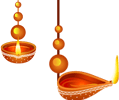
AstroVed Temple Services for Nalvar
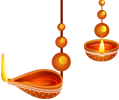
AstroVed Temple Services for Nalvar
Nalvar (Appar, Sundarar, Manikavasagar and Sambandar)
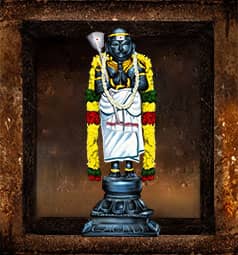
Tirunavukkarasar (Appar)
Appar, also known as Tirunavukkarasar (Lord of Language), was a prominent saint of the seventh- century and one of the 63 Shaivite saints called Nayanmars. At birth, he was called Marulneekkiyar and later as “father” by Sambandar, hence the name “Appar.” Appar composed 4900 hymns, which are found in the Saint’s collective works, called Thevaram. According to ancient texts, it is believed that Appar performed many miracles by rendering his hymns. He is depicted as a bald saint with a cleaning tool called “Uzhavaram” on his shoulder and hands in a praying position.
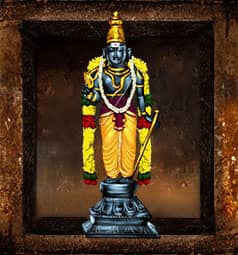
Sundaramurthy Nayanar (Sundarar)
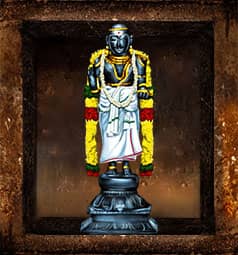
Manikavasagar
Manikavasagar, or Manikkavacakar is a ninth-century poet whose greatest works are collected in Tirumurai. His name means ‘the man with words as precious as the rubies.’ According to ancient texts, the story of Manikavasagar is associated with his birthplace, Vadavoor. He was a bright scholar and eventually became the Prime Minister of the King’s Court. The King sent him to obtain some horses, and on his way, he met Lord Shiva instructing disciples. He immediately surrendered to the Lord and became his disciple. The saint is depicted in a standing pose wearing a rudraksha mala and holding the praying beads in his right hand and palm leaves in his left hand. Devotees worship him for wise children and to cure stammering problems.
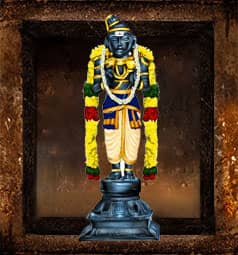
Thirugnana Sambandar
Thirugnana Sambandar was a Saivite Saint of the seventh century and was a contemporary of Saint Appar. He was one of the most prominent of the 63 Nayanmars and has composed 16000 hymns, of which 383 hymns have been recovered and are referred to as Thirukkadaikappu. The names of all 63 saints were recorded by Sundarar in Tiruthonda Thogai. Sambandar was born in a Brahmin family, and when he was three years old, he sang his first hymn, ‘Thodudaya Seviyan,’ after encountering Lord Shiva and Mother Parvati. At the age of seven, he recited the Vedas with clarity and visited several Shiva temples along with his traveling companion, Appar. He also performed several miracles by rendering his hymns. For example, he brought back to life a man and a businessman’s daughter, who were bitten by snakes. Sambandar is depicted holding two symbols vertically in his hand, making music. Devotees pray to him for intelligent and obedient children and to remove ailments.
Nalvar Pooja
As per traditional practices, devotees pray to Appar for wish fulfillment and relief from ailments, especially stomach-related disorders.
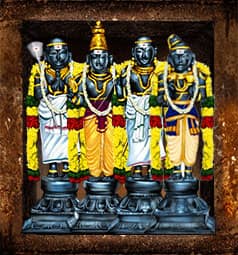
Water Abishekam (Hydration Ceremony) to Nalvar Saints
Water is the most common ingredient used in Abishekam. Performing Water Abishekam to Nalvar Saints can help calm the mind and liberate you from negative influences and evil energies.
Milk Abishekam (Hydration Ceremony) to Nalvar Saints
As per Sacred texts, performing Abishekam to Nalvar Saints with Milk can provide relief from diseases, remove sins, restore good health, and bestow longevity.
Honey Abishekam (Hydration Ceremony) to Nalvar Saints
Honey is a therapeutic ingredient known for its curative benefits. When used in the Sacred bath to the Nalvar Saints, it can remove sorrows and bestow happiness.
Tender Coconut Water Abishekam (Hydration Ceremony) to Nalvar Saints
Coconut Water Abishekam can help you gain blessings for satisfaction and enjoyment of life and the overall welfare of the family.
Curd Abishekam (Hydration Ceremony) to Nalvar Saints
As per traditional belief, freshly prepared curd or yogurt used in performing Abishekam to Nalvar Saints can keep misfortunes and bad luck at bay and grant progeny blessings.
Rose Water Abishekam (Hydration Ceremony) to Nalvar Saints
Rosewater is a fragrant ingredient used in Abishekam to the Nalvar Saints to receive their blessings to balance emotions, receive wealth and prosperity, and remove negative character traits.
Turmeric Abishekam (Hydration Ceremony) to Nalvar Saints
As per Sacred texts, turmeric can confer auspiciousness and help you gain restorative blessings from the Divine. Performing this Abishekam to Nalvar Saints can help cure illnesses and ailments and increase your overall well-being.
Sandal Paste Abishekam (Hydration Ceremony) to Nalvar Saints
As per Sacred scriptures, Sandalwood is dearly loved by Shiva, as it cools down his rage and anger. Therefore, performing Abishekam with Sandalwood Paste gains blessings for fame, luck, wealth, and power in society.
Nalvar Homa (Fire Lab for Spiritual Growth)
The Nalvar are four of the foremost fervent devotees of Shiva, the 63 Nayanars. Performing the Nalvar Homa can inculcate sincere faith, and enhance love, devotion, and spiritual growth. It leads to the path of enlightenment to attain the Supreme Being, Shiva.
Frequency of the Homa
1 Individual Homa:
The Nalvar are four of the foremost fervent devotees of Shiva, the 63 Nayanars. Performing the Nalvar Homa can inculcate sincere faith, and enhance love, devotion, and spiritual growth. It leads to the path of enlightenment to attain the Supreme Being, Shiva.
3 months:
The Nalvar Homa will be performed once every month for 3 months. The Nalvar are four of the foremost fervent devotees of Shiva, the 63 Nayanars. Performing the Nalvar Homa can inculcate sincere faith, and enhance love, devotion, and spiritual growth. It leads to the path of enlightenment to attain the Supreme Being, Shiva.
6 months:
The alvar Homa will be performed once every month for 6 months. The Nalvar are four of the foremost fervent devotees of Shiva, the 63 Nayanars. Performing the Nalvar Homa can inculcate sincere faith, and enhance love, devotion, and spiritual growth. It leads to the path of enlightenment to attain the Supreme Being, Shiva.
12 months:
The Nalvar Homa will be performed once every month for 12 months. The Nalvar are four of the foremost fervent devotees of Shiva, the 63 Nayanars. Performing the Nalvar Homa can inculcate sincere faith, and enhance love, devotion, and spiritual growth. It leads to the path of enlightenment to attain the Supreme Being, Shiva.
Nalvar Homa (Fire Lab for Spiritual Growth)
Introduction to Nalvar Homa
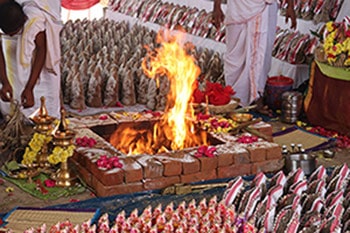
The most prominent Nayanars (the saintly Shiva worshippers) were Appar, Sambandar, and Sundarar, composers of the Thevaram hymns. The Nayanars emerged between the 7th and 9th centuries. They were extremely pious and were from all walks of life. They dedicated themselves to Shiva worship and composing devotional hymns, sung even today. Along with Manikkavasagar, composer of the Tirukovayar and Tiruvasakam, they are called the Samayacharyas (the teachers of faith). In Tamil, they are called the ‘Nalvar,’ meaning the four. They were the four great Shaiva saints revered across South India. Their songs revitalized the minds of the people and inspired generations down the line.
Unique Traits of Nalvar
The Nalvar were proponents of the Shaiva Siddhantha, the philosophy that propagates Shiva is love, which is the key to attaining him, the Supreme Being. The Nalvar provided a resurgence to Shaivism and were believed to be the four pillars, traveling the length and breadth of Tamil Nadu. They kindled the belief that one can live in spiritual bliss to attain supreme liberation, sing and hail Shiva, and the truth of the four holy Vedas. Hence, they were called the Samayak Kuravagal.
The Tamil compilation of the devotional songs by the Nalvar is called Tirumurai. Along with the Vedas, Sacred texts, Shaiva Agamas, and Meykanda Shastras, they form the scriptural basis of the Shiva system of worship in Tamil Nadu. Performing the Nalvar Homa can inspire and instill immense faith and devotion and enhance spiritual growth.
Description of Nalvar Homa
The Nalvar initiated the philosophy of Shaivism- the Shaiva Siddhantha, where a devotee aims to become enlightened through the grace of Shiva. It is a southern tradition and very much in existence. The Nalvar statues are separately installed in some Powerspots in Tamil Nadu. As per traditional belief, performing the Nalvar Homa can instill immense faith, inspiration, and devotion and enhance spiritual growth. It can help one on the path of spiritual elevation.
Benefits of Nalvar Homa
As per traditional belief, performing the Nalvar Homa can grant the following blessings:
- Instill immense faith and inspiration
- Enhance devotion
- Enable spiritual growth
- Help attain liberation
What will I receive?
You will receive Sacred grey ash blessed in the Homa. It can be kept in the prayer altar and duly applied on your forehead whenever you seek the blessings of the deities.
Note: The shipment of the Prasad for Poojas/Abishekam starts only after the completion of the service.

